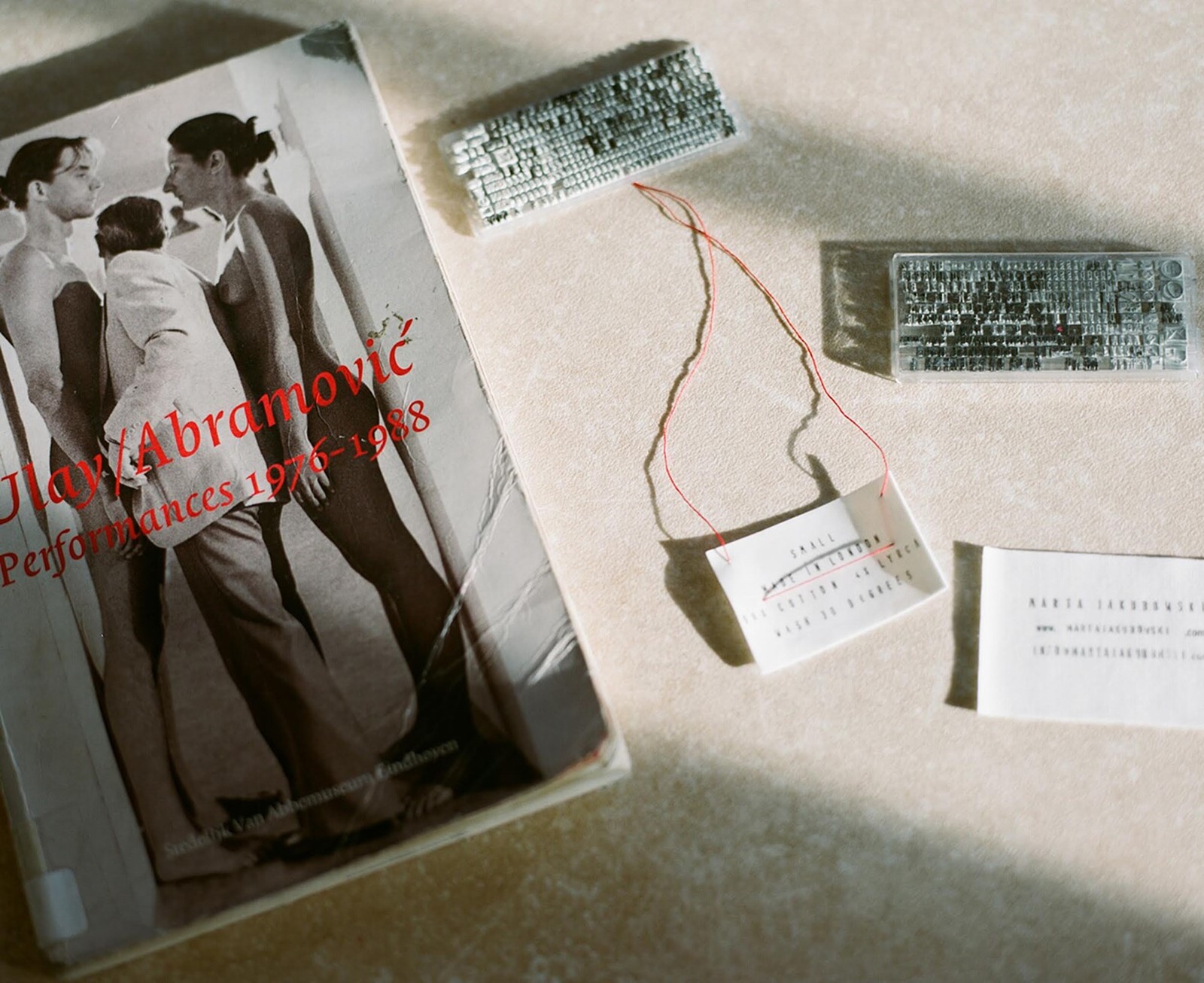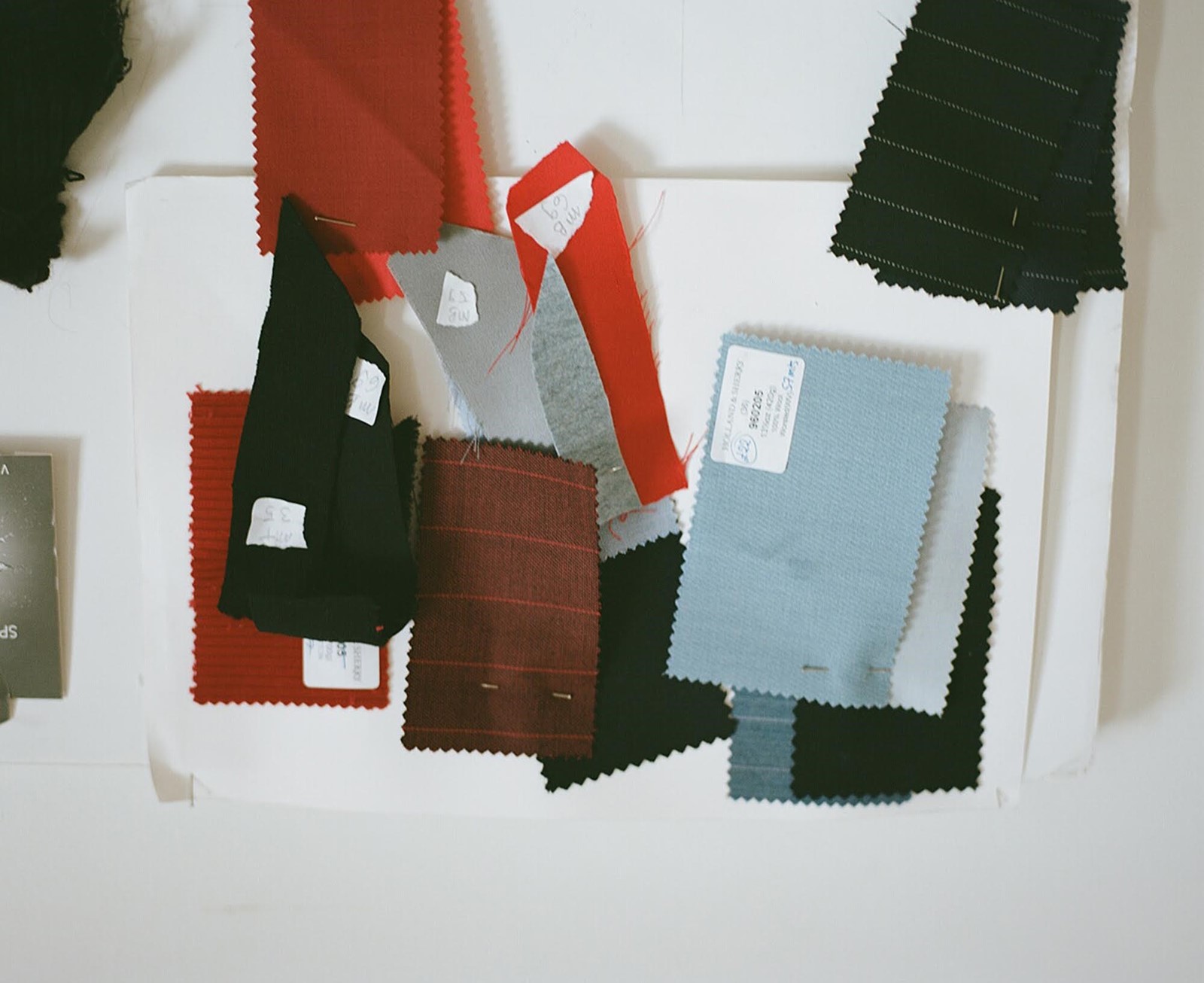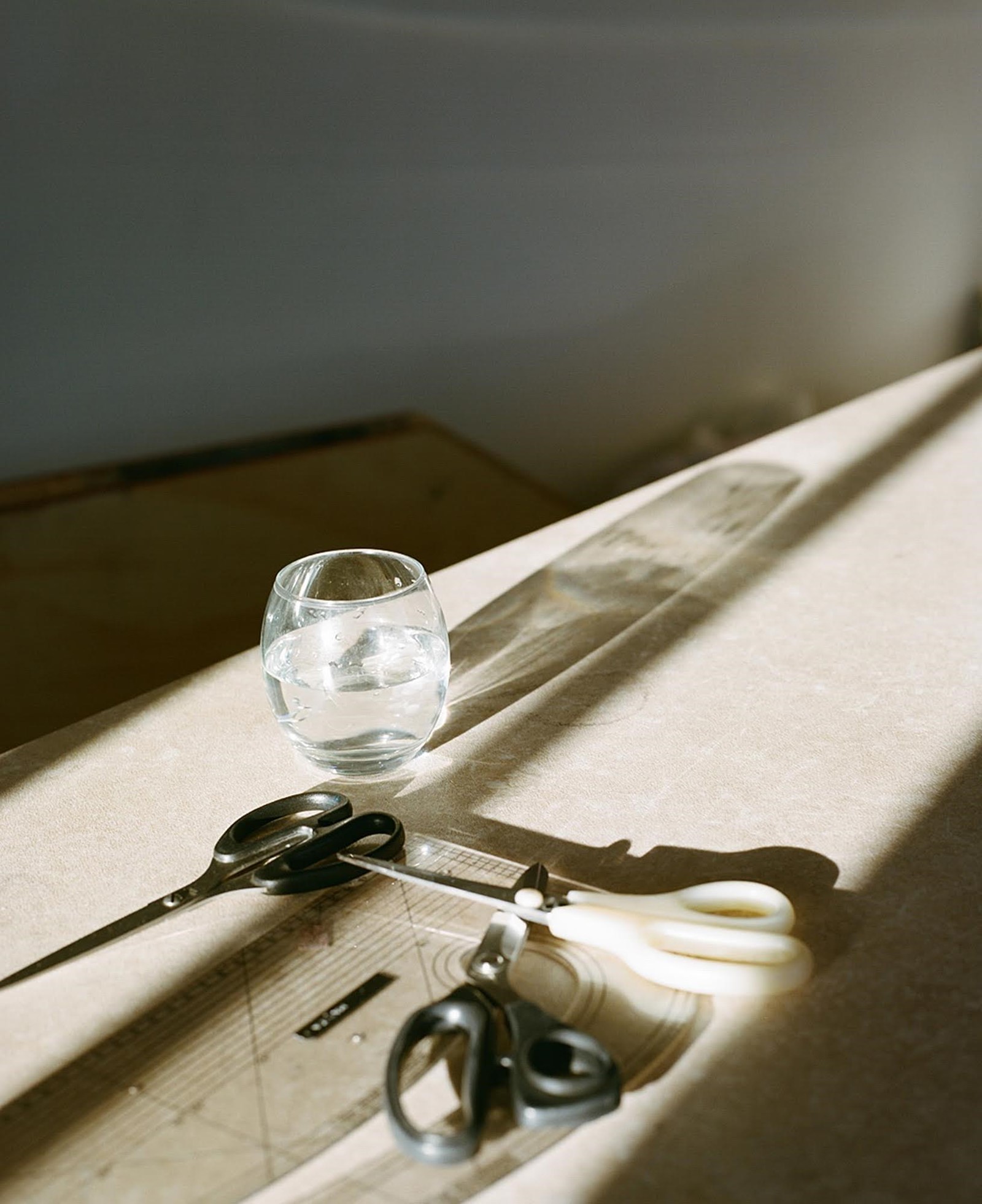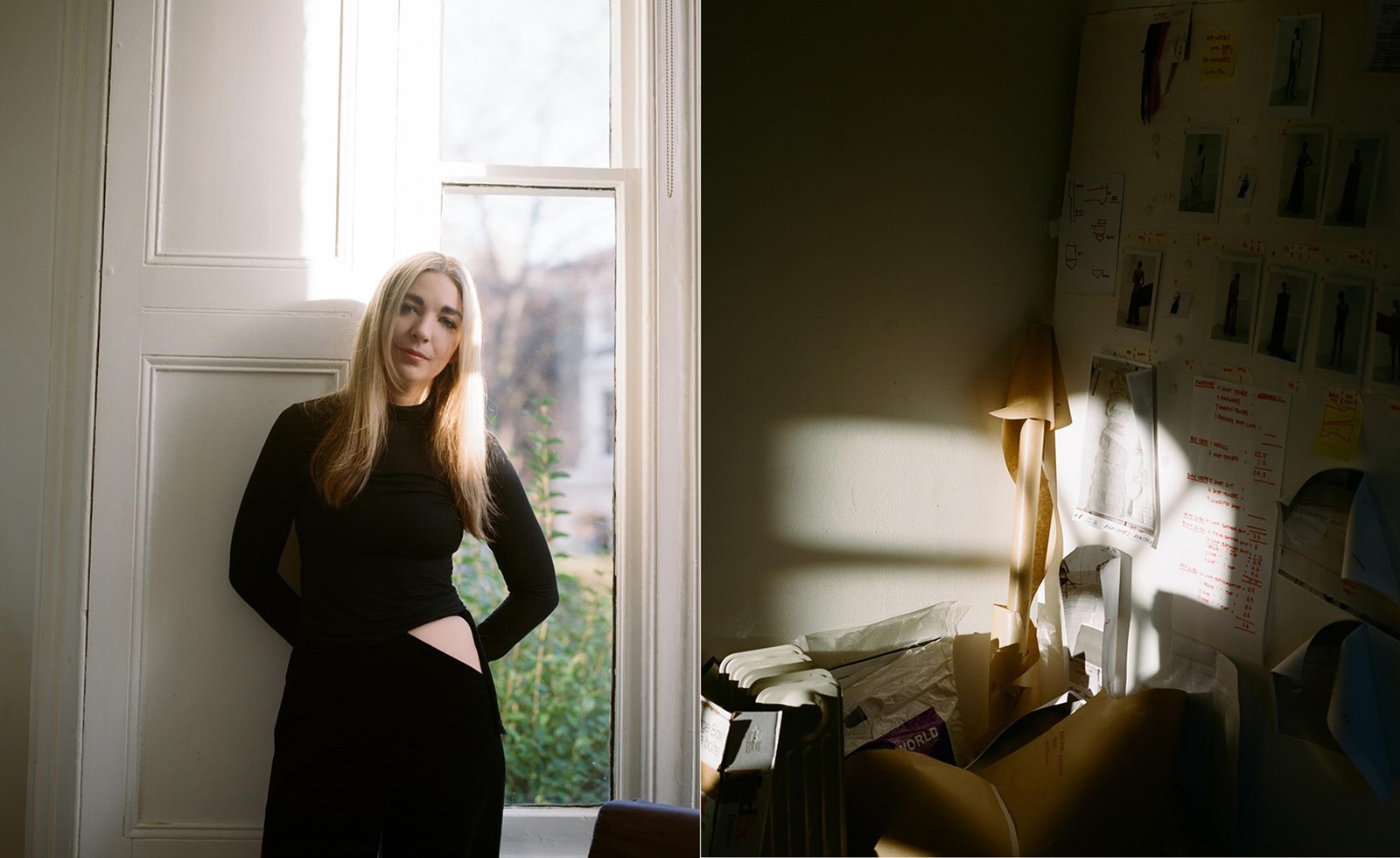Marta Jakubowski is fresh off the boat from the British Fashion Awards. A couple of nights before our interview I bump into her at the afterparty, chatting away to FKA Twigs. Did she know her? No. That’s just down to Jakubowski’s ability strike up conversation with just about anyone. She’s blind to the guarded atmosphere of corporate cocktail parties, probably because she’s been on the shop floor since the age of 14 (and still supports herself by doing so). This lack of pretension is not only key to her charm, but equally to her work: her two collections have made impressive waves throughout the industry, their subversion of simplicity garnering industry attention despite S/S16 only being shown in the NewGen Showroom.
This most recent offering explored the theme of hospital environments, combining restrictive panels with cutaway slits and drapes of extra fabric, which when held up flooded the body in her preferred palette of white, red and black. The inspiration is close to home considering the designer spent a great amount of time in hospitals visiting her late mother. “I was always intimidated and fascinated at the same time,” she says of the clinical atmosphere. “Every weekend I would go and see my mum in the hospital whereas other children would be going to their family’s houses. I was always looking at medical supplies and braces and all of the details and you can see that in all of my collections.”

Jakubowski graduated from the Royal College of Art in 2014. Her final collection was quite literally a stream of fabric connecting various tailored looks that were upheld by scaffold-like braces and cleverly concealed fastenings. It explored the fundamental connectivity between people, and an outward expression of the darker emotions associated with grief and depression. The streams of red fabric emerging from one model’s mouth or the smaller panels of black drapes on another model’s eyes were a statement of mixed emotions; the visual expressions of muteness, sickness and weeping, whilst the slits acted as tears, evoking the idea of bare flesh ripped through.
“If you’re feeling sad you have to make a sad collection” – Marta Jakubowski
It’s fair to say that these inspirations were a direct result of Jakubowski’s rather unconventional mood board, which consisted of video artwork that she made herself at the encouragement of her tutor David Kappo. “He said that you can’t fake it; if you’re feeling sad you have to make a sad collection,” she recalls. Having failed to find any imagery or references that inspired her, she took cues from artists that explore issues of self, such as Francesca Woodman and Marina Abramović, and created haunting short films that were primarily a way of visualising and confronting her own feelings at the time.
The themes continued into her research for S/S16, which included the photojournalism of Jane Evelyn Atwood, who journeyed to female prisons for over a decade to interview and photograph inmates for her groundbreaking book Too Much Time. “That’s what I’d love to do one day: documentary fashion. I wanted to be a psychologist but I confused it a lot with being a social worker,” she says of her earlier ambitions. “I’ve met a few [psychologists] and they’re not very warm or understanding of people’s emotions. They’re very reserved and I think I would have actually preferred to be more hands-on with helping people.”

It’s this orbit of the self-expression of female artists that informs Jakubowski’s 'girl'. As any graduate of the RCA will know, the course has a ‘personality project,’ in which designers dream up a world around their girl – envisioning everything from what she eats, drinks and reads to what she loves and hates. “If I talk about her, she seems like a dick,” Jakubowski laughs. “But I think it’s really important. When I worked at Alexander Wang, he always knew who his girl was and how he could convey her in a collection. My girl is kind of like my alter ego. Beyoncé has Sasha and I have her. I think it’s either something that I want to be or something that I want to get rid of.”
“My girl is kind of like my alter ego. Beyoncé has Sasha and I have her” – Marta Jakubowski
This girl has evolved season to season thus far, and where she may have been hospitalised last season – “She was a bit mad but mainly misunderstood” – for A/W16 she’ll be mentally and physically strong, inspired by the Shaolin Kung Fu camps where girls are trained to be fighters – but not necessarily aggressive. “The casting will be very important,” she explains. “She can’t be a 16-year-old girl who’s too fragile. I’ve been going to Kung Fu and Tai Chi classes and I’m hopefully going to cast some women from there.” On her mood board are various swatches of surprisingly colourful fabrics. Could this be a move away from her starkly defined colour palette? “So far a lot of the themes and artists I’ve been looking at aren’t fun and colourful,” she says, motioning towards the stack of photography books on her table. “Every season I try and add some more colour and, by the end, it just doesn’t fit. What colours would you give this woman? She won’t like pink, y’know?”
Jakubowski is part of the current wave of London’s emerging designers making their mark on the industry. What does she think makes the city such a breeding ground for creativity? “If I look at the big French and Italian fashion houses, I can’t say whose collection is who, so it’s really confusing,” she answers. “If you put all those clothes on one wall I wouldn’t be able to tell the difference, but in London, you can tell that’s Nasir and that’s Ed Marler.” I suggest that it may be to do with the education system here – or the openness to criticism and honesty. “There was a lot of criticism when I interviewed for NewGen, but they’re the best people to judge. It was the same with my tutors – you really need that. Who else in fashion is going to tell you the truth?”

But what London exudes in creativity, it lacks in financial stability – especially for students and young people. Having grown up in Mainz, a medium-sized town not far from Frankfurt, Jakubowski studied fashion design at the local college in Trier, Southwest Germany, where she had a studio for 120€ a month and was able to save money and spend her time concentrating on college. She took a placement year in Antwerp, working for Bruno Pieters, before returning to Germany to finish her BA. “I moved to London and was working for Hussein Chalayan and Jonathan Saunders before starting my MA. It was hard – I had to work, in retail at weekends and three days a week at a café,” she stresses. “In London, you have less space, less time and shit loads of money to pay, so you become really desperate to create something amazing because you have to. In cities liked Antwerp you have more space and time but it’s not always best for your education because you don’t have that…” – she clicks her fingers – “…that drive.”
"In the end, what you have to do is make clothes and sell them. That’s what Coco Chanel used to do" – Marta Jakubowski
She chuckles when recalling the cost-saving shortcuts that saw her through her studies, such as going to Berwick Street to get samples of fabric and then hopping on the tube to the considerably cheaper Shepherds Bush Market. “I’d say, ‘Oh, I bought this fabric here!’ and they would look for you and get something similar. It’s the same quality, really.” Another element of Jakubowski’s charm (and success, considering she graduated a year ago) is that she’s wonderfully enterprising. “I learned a lot from working with great designers and my direct boss was almost always a strong woman working underneath the designer, dealing with every aspect of the business,” she says. “Learning how to do the production is hard because, effectively, it’s a different world to what you’re used to, but I love doing sales because I’ve done it all my life. I can’t imagine a designer these days sitting in their studio being shy. You have to become this businessperson, which I don’t mind doing and, anyway, you learn from your mistakes.”
Does she consider herself brave for setting up shop so soon after graduation in a difficult climate? “If you’re scared you shouldn’t do it. People speak about the tuition fees and costs of being a young designer and say that they can’t do it, but I believe that where there’s a will, there’s a way. In the end, what you have to do is make clothes and sell them. That’s what Coco Chanel used to do. I know from working in retail how much money people spend on clothes – it’s a very big market. Even when I was 14, every Friday I’d spend the £100 that I earned during the week entirely on clothes. I hear it all the time from young kids: ‘I don’t need it but, I want it.’ That’s what I want: people to want it.”
